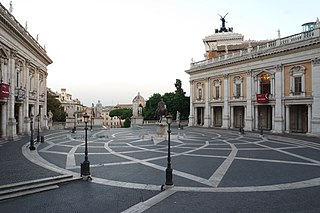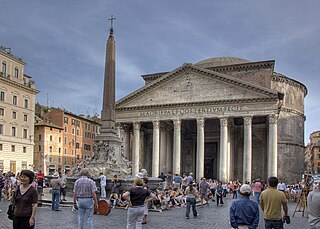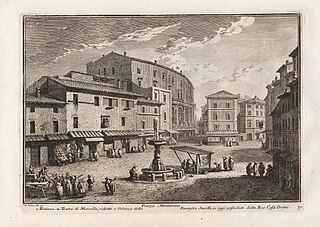
The Quirinal Hill is one of the Seven Hills of Rome, at the north-east of the city center. It is the location of the official residence of the Italian head of state, who resides in the Quirinal Palace; by metonymy "the Quirinal" has come to stand for the Italian president. The Quirinal Palace has an extension of 1.2 million square feet.

The Capitolium or Capitoline Hill, between the Forum and the Campus Martius, is one of the Seven Hills of Rome.

Trastevere is the 13th rione of Rome: it is identified by the initials R. XIII and it is located within Municipio I. Its name comes from Latin trans Tiberim, literally 'beyond the Tiber'.

Piazza del Campo is the main public space of the historic center of Siena, Tuscany, Italy and is regarded as one of Europe's greatest medieval squares. It is renowned worldwide for its beauty and architectural integrity. The Palazzo Pubblico and its Torre del Mangia, as well as various palazzi signorili surround the shell-shaped piazza. At the northwest edge is the Fonte Gaia.

The Victor Emmanuel II National Monument, also known as Vittoriano or Altare della Patria, is a large national monument built between 1885 and 1935 to honour Victor Emmanuel II, the first king of a unified Italy, in Rome, Italy. It occupies a site between the Piazza Venezia and the Capitoline Hill. The monument was realized by Giuseppe Sacconi.

Piazza del Campidoglio is a public square on the top of the ancient Capitoline Hill, between the Roman Forum and the Campus Martius in Rome, Italy. The square includes three main buildings, the Capitoline Museums, Palazzo Senatorio, and the Palazzo Nuovo. The hilltop square was designed by Michelangelo in the 16th century. Palazzo Senatorio is today the seat of the Municipality of Rome. The Capitoline Museums are the oldest public museums in the world. They are a group of art and archeological museums in the plaza that include Palazzo dei Conservatori and Palazzo Nuovo.

Ponte is the 5th rione of Rome, identified by the initials R. V, and is located in Municipio I. Its name comes from Ponte Sant'Angelo, which connects Ponte with the rione of Borgo. This bridge was built by Emperor Hadrian in 134 AD to connect his mausoleum to the rest of the city. Though Pope Sixtus V changed the rione limits, so that the bridge belongs now to Borgo, not to Ponte anymore, the area has kept its name and a bridge as its coat of arms.

Sant'Eustachio is the 8th rione of Rome, identified by the initials R. VIII. It is named after the eponymous church and is located within the Municipio I.

Pigna is the 9th rione of Rome, identified by the initials R. IX, and belongs to the Municipio I. The name means "pine cone" in Italian, and the symbol of the rione is the colossal bronze pine cone standing in the middle of the homonymous fountain. The fountain, that was initially located in the Baths of Agrippa, now decorates a vast niche in the wall of the Vatican facing the Cortile della Pigna, located in Vatican City.

Borgo is the 14th rione of Rome, Italy. It is identified by the initials R. XIV and is included within Municipio I.

Castro Pretorio is the 18th rione of Rome (Italy), identified by the initials R. XVIII, and it is located within the Municipio I. The rione takes its name by the ruins of the Castrum Praetorium, the barracks of the Praetorian Guard, included in the Aurelian Walls.

Celio is the 19th rione of Rome, identified by the initials R. XIX, and is located within the Municipio I.

Prati is the 22nd rione of Rome, identified by the initials R. XXII. It belongs to the Municipio I since 2013, while previously, along with Borgo and quartieri Trionfale and Della Vittoria, it was part of the Municipio XVII.

Campo Marzio is the 4th rione of Rome, identified by the initials R. IV. It belongs to the Municipio I and covers a smaller section of the area of the ancient Campus Martius. The logo of this rione is a silver crescent on a blue background.

Giacomo della Porta (1532–1602) was an Italian architect and sculptor, who worked on many important buildings in Rome, including St. Peter's Basilica. He was born at Porlezza, Lombardy and died in Rome.

Piazza del Popolo is a large urban square in Rome. The name in modern Italian literally means "People's Square", but historically it derives from the poplars after which the church of Santa Maria del Popolo, in the northeast corner of the piazza, takes its name.

The Piazza della Rotonda is a piazza in Rome, Italy, on the south side of which is located the Pantheon. The square gets its name from the Pantheon's informal title as the church of Santa Maria Rotonda.

Via di Ripetta, also called Via Ripetta, is a street in the historic centre of Rome (Italy), in the rione Campo Marzio, that links Piazza del Popolo to Via del Clementino and, with other toponyms, reaches the church of Sant'Ivo alla Sapienza, on the back of Piazza Sant'Eustachio and close to the Pantheon. It is part of the complex of streets known as Tridente.

Piazza Montanara was an ancient and picturesque square of Rome (Italy) located at the foot of the Tarpeian Rock, in close proximity to the Capitolium and partially bounded by the Theatre of Marcellus.
Now it has completely disappeared following the demolition of the Fascist era, to create the initial stretch of Via del Mare, later called Via del Teatro di Marcello. The destruction of Piazza Montanara was part of a larger project of "isolation" of the Capitoline Hill, which ended up completely erasing the district of medieval origin that surrounded its east and south-east slopes.

The Monument to Cola di Rienzo is a bronze statue dedicated to the 14th-century Roman politician and military leader, and prominently displayed in the space between the steps leading up to the Campidoglio and the steps leading up to Santa Maria in Aracoeli, in Rome, Italy.




















